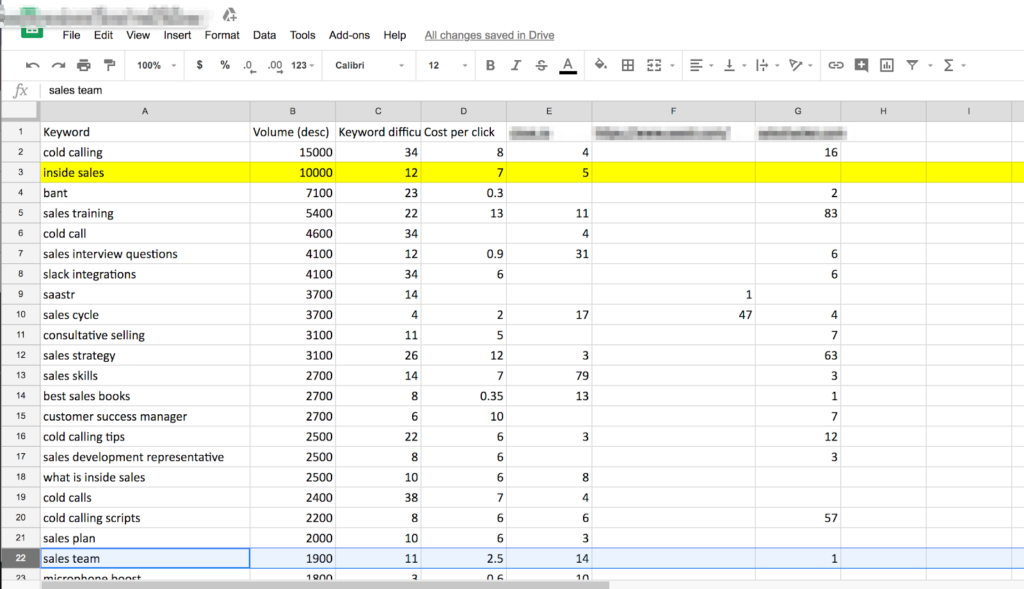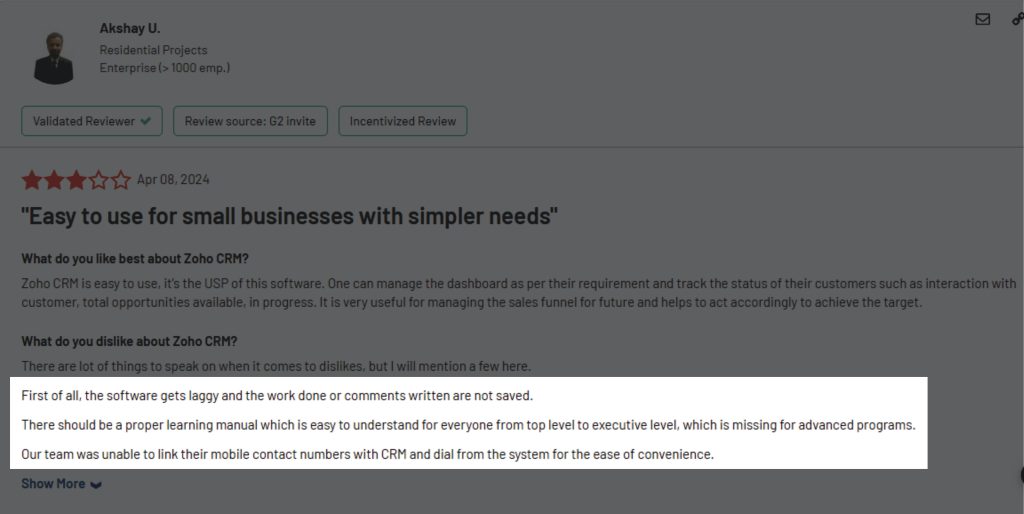Many B2B SaaS marketing teams fall flat in their content marketing approach. Instead of leveraging pain point SEO keywords that drive conversions, they prioritize high-volume keywords geared toward increasing website traffic.
Their proven standard for developing a content strategy often follows after this process:
- Marketers research high-volume, top-of-funnel keywords related to the interests of their target audience.
- They use the keywords to craft topics and schedule blog posts for the entire month.
The interest-based keyword approach often ends up with a list of keywords that look something like this:

While these keywords tend to pull a good amount of traffic, they end up driving little to no conversions. In most cases, they boost impressions and increase email and newsletter signups which can take forever to nurture.
The concept behind pain point SEO is to identify your audience’s problems and craft content that solves those problems. The deeper you understand their pain points, the better it is to craft content that resonates.
To help you develop a result-driven SEO content marketing strategy, you need to first understand why your typical content marketing approach doesn’t work. Then we’ll explore how you can align your B2B SaaS product features to your audience’s pain points.
Why Typical SEO Strategy for B2B SaaS Products Doesn’t Work
When marketers focus on high-volume, top-of-funnel keywords, their #1 objective is to beat the competition on Google and drive traffic to their website, forgetting that those search terms don’t drive desirable free trial signups and demo requests.
This implies that doing SEO for B2B SaaS products is not just about driving topically relevant traffic to your website, it involves targeting people with specific problems and crafting pain point SEO blog posts that show them how your product’s features solve those problems.
Picture this. You’re a SaaS company with AI note-taker software which sales teams find important to transcribe, analyze, and summarize voice conversations.
The fact that “sales teams” are your right audience doesn’t mean you must cover every keyword related to sales teams to attract potential customers.
For example, if you try to rank for the keyword “CRM meaning” with 60.5k monthly search volume and write a blog post around “What is CRM (Customer Relationship Management)?” (which also has 27.1k monthly search volume).

There is no evidence that anyone reading the content will sign up for your product. Because they are not looking to buy AI note-taking software. They are only trying to learn about CRM.
That’s why high-volume, top-of-funnel keywords don’t usually work for SaaS products.
That said, let’s head straight to better ways of doing SEO for SaaS products.
Align Pain Points to Product Features to Boost Conversion
Regardless of the industry you serve, your B2B SaaS product has key features that make life easier for your customers. That’s where the solution you need to boost conversion lies.
Starting with your topic, your blog posts must resonate with your audience’s search intent. That’s when you can promote your product as the ultimate solution within the content.
For instance, a better blog topic for the AI note-taker software (mentioned earlier) is “how sales call recording can improve sales performance”.
This topic shows that there is a problem your software can solve for sales teams. You need to first address the search query, then introduce your AI note-taker software as the automation tool for simplifying note-taking — transcribing, analyzing, and summarizing voice conversations — in a meeting.
Once this tool solves your audience’s pain point (i.e., sales call recording), sales teams can then focus on building relationships and closing deals.
The takeaway here is to make sure that your blog topics and content align with specific pain points your product can solve.
Here’s how to do that:
Identify Your Audience’s Pain Points
Never assume you know your audience’s pain points. If you think you do, your content marketing efforts will fail woefully.
It is only when you conduct qualitative research that you can know what problems your audience is facing. Then you can provide the right solution through your blog posts.
The methods below will help you identify your audience’s pain points.
Method #1: Ask open-ended questions
Through open-ended questions, your target audience can share their feelings, opinions, and experiences. You can ask open-ended questions through multiple channels, such as webinars, short surveys, social media, and live chat.
Some of the questions you can ask include:
- What is the biggest challenge in your industry?
- What are you currently doing to manage the problem?
- What consequences are you likely to face if the problem persists?
- If solved, what are your expectations? Etc.
Method #2: Check online forums
First, you need to find forums with audiences in your niche. Use Google to search for niche-related forums, such as “graphic design forums”.

You should also consider checking niche-related topics on Facebook groups, Subreddit on Reddit, and Quora.
If none of these forums dive deeper into your audience’s pain points, you can start a new thread and title it: “What problems are you currently facing in [niche]?”
Method #3: Analyze your competitors
Check your competitors’ websites, blogs, testimonials, case studies, and social media platforms to see what pain points they address and the solutions they offer. This can also be a great way to identify the weaknesses of your competitors and find a better way to improve on them.
Method #4: Use buyer personas
You can use social media, surveys, feedback, interviews, or analytics to create detailed buyer personas. Taking this step will help you gather information (such as demographics, challenges, and motivations) about your audience to identify their pain points.
Method #5: Read reviews
When you go to software review platforms, such as Capterra, G2, TrustRadius, Software Advice, and GetApp, you can easily figure out the pain points of your audience. Read the negative reviews, especially those with one and two-star ratings. Then jot down all the pain points.

Once you fleshed out the negative experiences users have, then it’s time to build an editorial calendar.
Build an Editorial Calendar with Low Hanging Fruit (Pain Point/Low-Volume Keywords)
Instead of going by the volume-based keyword strategy, use buyer intent to find the right keywords and topics that discuss your audience’s pain points and write blog posts around them.
This approach can help match search intent with the buyer’s journey, allowing your post to generate leads and signups, rather than merely measuring a boost in traffic.
The steps you must follow to buid an editorial calendar with pain point SEO keywords include:
- Ideate topics that generate leads
- Create a storytelling angle within your blog posts that shows real user pain points
- Craft your blog posts to demonstrate how your product features solve user problems
1. Ideate topics that generate leads
There are two main content structures for ideating conversion-focused topics for SEO content. They are:
- Category keywords: These are keyword phrases relating to your offer, such as “SaaS content writer”, “customer retention software“, etc. People searching for these terms aren’t looking to be educated; they are on the market to buy. Consider creating blog topics with search terms (and related keywords) that correspond to your offer.
- Comparison and alternative keywords: These search terms show searchers comparing two products or looking for the best alternative, such as “Mailchimp vs MailerLite” or “best HubSpot alternative”. People on this buyer’s journey are engrossed in decision-making between two products or making a switch. So, use “comparison” and “best alternative” keywords to craft a variation of blog topics.
2. Show your audience that you understand their pain points from a unique storytelling angle
Once you find topics for your publishing dates, you need to craft a storytelling angle within each blog post to show your audience how much you understand their pain points.
Let’s examine a business is searching for the best alternative to Mailchimp email marketing service. To convince this business that your product is better, you need to first analyze common problems with Mailchimp by citing a real user experience.
Doing this will convince your prospective customers that you truly understand what they are going through, and they’ll be more than willing to give your product a try.
3. Introduce your product features as the ultimate solution
At this stage, you need to prove your competency and close the deal — make that prospect request a demo or sign up for a free trial.
You don’t need to make your copy sound salesy; you only need to align particular features of your product to your audience’s pain points, allowing them to see how that feature solves their problem.
Let’s take a further look at Mailchimp. After highlighting the problems with the email marketing service, the next step is to introduce your product and explain why it is a better alternative.
Walk prospects through detailed information on the following:
- How your software works
- Its user interface
- Whether it has a learning curve or not
- If there are any resource materials
- Its integration capability
- Availability of the support team
Don’t forget to mention your pricing, too. By the time you finish discussing the value you bring to the table (without hard-selling), you will discover that more companies will fall in love with your product.
Get More Product Signups with Pain Point SEO
Now that you understand how to craft content that matches pain point SEO with product features, you can start building a content marketing strategy that’ll help you forecast your SEO growth.

